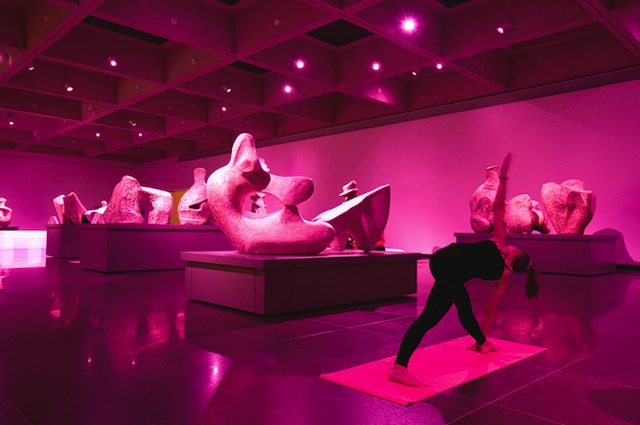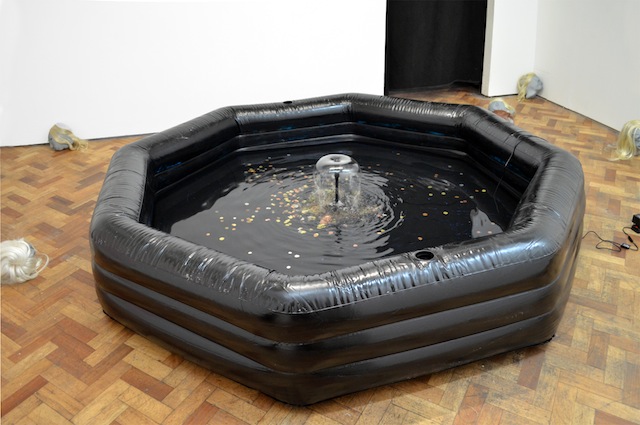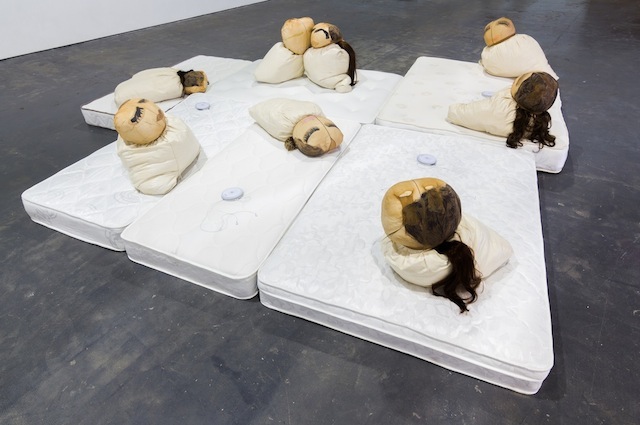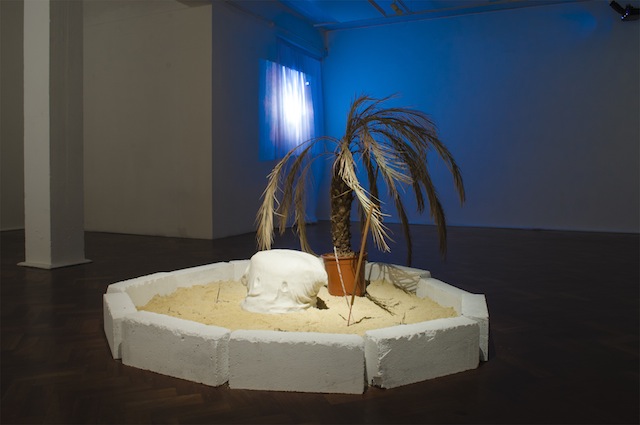Megan Rooney and I both grew up on the frayed edges of Toronto’s sprawling suburbia, and it shows in strange, imperceptible ways that I’m somehow always newly surprised by. You can see it in random, erratic things, in our shared nostalgia for Henry Moore’s monolithic women lying permanently along the floors of the Art Gallery of Ontario (AGO), or for teendoms spent in North American malls as a sort of female rite of passage. You can also see it in the way we react to ‘othered’ things, the equal parts affinity and disgust at the candy-coloured California dreams of the coast, for example, or the outsider’s fascination with sleek Parisian woman gliding through distinctly non-North American boutiques.
Rooney did an entire piece about that, lurking in the shimmering hallways of the Galeries Lafayette, a Parisian department store for which she created an audio piece to be used as a sort of audio tour as part of Paul Kneale and Raphael Hefti‘s Pleasure Principles project. The work arose out of her residency at Foundation Galeries Lafayette, an art foundation historically separate from the luxury retail company despite being funded by it. “I was interested in bringing out that connection to explore both the relationship between art and commerce and my own personal fascination with the behaviours and aesthetics present in this Parisian luxury store,” says Rooney in an email “[B]oth sites refer to each other. At the exhibition you’re informed you need to go to the mall to see all the work. At the mall, your shopping experience, so carefully constructed, is punctured by work that does not directly correspond with the shopping or browsing behaviours you’re otherwise programmed to enact in that space. So you’re doubly displaced.”
We conduct the entire interview over email, and Rooney painstakingly edits her answers in the way that anyone wedded to language inevitably does. When I inform her we have to make cuts, she balks: “I have answered the questions in a kind of form itself, I think it’s a shame to shred it apart simply to make it shorter.” I get it; I once fought an editor tooth and nail for an entire day over a semicolon. (The semicolon stayed, but I never wrote for that publication again.) To Rooney, I’m sympathetic but unbudging. Still, when I cut one whole answer to make the word count, I feel remorseful; it, too, was good.

What was it about your sound piece Pleasure & Charity that belonged at the AGO?
Megan Rooney: I don’t really like the idea of ‘site-specific’, because I think it implies a static place, and I believe that context is always changing, even in a big museum. That was an important starting point for that work. I had visited the AGO many times growing up in Toronto and that room full of Moore’s sculptures has always seemed very heroic, masculine, and esoteric to me. So I think I had a desire to invert all of those things. Make it quotidian, gaudy pink and concrete. I thought if I could turn this austere modernist city tomb into a suburban strip-club-cum yoga studio it would be an adequate background for the audio I wanted to create. It was an amazing feeling of power to be able to subvert the environment that the authority of the museum designates as appropriate for its masterpieces.
I’m keenly aware of the aesthetics and social codes of place and this lurid suburban taste seemed to me like an unwelcome reality that the museum didn’t want to let in. That I didn’t want to let in either really. There was some kind of self-harm involved in reproducing this taste. Which is also a kind of evasiveness that’s sometimes necessary when you’re facing such a monolithic context. The sound work was developed specially for that setting, with the rented white leatherette furniture and bright pink lighting and yoga girls in mind. I think its one of my most acerbic texts. There are bits that are definitely processing some darker feelings about this suburban culture I’m evoking.
What was some of the thought process behind your Affluent Insights show at Lima Zulu?
MR: I started making the work for Lima Zulu directly after spending a lot of time hanging out at a shopping mall in Paris. It brought me back to my days as a teenager growing up in the suburbs of Toronto, where the mall was the most important social space, a kind of corporate public square, where all your friendships, loves and boredom were played out. There’s some kind of rift between how you would characterise the things people are doing there, which are all very consumer-oriented, and the empathetic knowledge one has of the psychological attachments that one forms to the place with real feelings. Real memories.
When I started making my show at LZ, I was really aware of the atmosphere of the space, it’s own cult following and set of attitudes that make it distinct in the landscape of London project spaces. That atmosphere blended in my mind with the atmosphere of the mall in Paris, and the one it evoked of my teenage mall in Toronto, and it became a hybrid in my imagination.
In general the subject matter of one show bleeds into the next for me, it’s all part of one giant work that I’m inviting people into, like a life. The work creates an experience that’s not a replica of life, but more like something where those half-corporate, half-personal memories have been made aesthetic, plastic. Something changes there. It makes you realise how memory is unreliable, always slyly attaching itself like a parasite onto the things around you. You think that its recorded, but actually you’re just seeing bits of your reflection. By making the work I can intervene into that. Create a parallel reality that doesn’t depend on my mind anymore, can have its own existence.

I love that—memory as nothing but your own reflection. Your work also scales along a lot of different media: drawing, sculpture, text, audio, video. What did you start with? Is there a combination you prefer?
MR: I think of these installations as one single work, with many parts. A type of story telling with objects. There is always a character involved. She’s always been drawn from a mix of personal experiences and the acute observation of woman in public situations (in transit, art parties, openings, at the nail salon, at bars and clubs at the places I have waitressed at). The characters are also drawn from memory, semi-biographical at times. I am always trying to create a specific feeling with each installation. To draw you, the viewer, into some kind of space outside of the universe or outside your computer, your bed, your scene. But inside a social system, or into a dream, a situation, a memory and then maybe you’re back in bed but the room feels different. And for me it’s about weaving things together and creating a space where different positions and experiences can exist at the same time in a network of complex relations. Not to describe the complexity but be able to look at it all and get closer to the real through a certain kind of irresponsibility. But it’s filtered too. The result is never chaos. We’re always managing our intake of the world. It’s an animal thing, but now also a high tech one. We repeat all our biggest problems, make variations based on who’s selling.
Somewhere in the making process the words come but the sculptures always have to exist in some way before that can happen. The words usually flow out quickly, late at night when the feeling is almost violent, like untangling all the various codes and your desires and you’re drinking lots of wine and having lots of sex. And if you push hard enough, maybe you can bring down the whole house, or maybe you don’t live in a house (I don’t). But you are in the studio and all those things exist together. The objects are always made by hand, often constructed out of clay and then cast in various materials. Plaster, resin, cement, faux marble. Messy at times, rough, wonky, imperfect and then other times they appear more finished, sexy and sleek. And I always tend to shy away from conventional display methods like plinths, because they seem to belong so strongly to the world of sales and I think I am always trying to lure my audience into some kind of world where they can forget about such things.

You’re also taking part in a group exhibition called Till the Stars Turn Cold at the S1 Artspace in Sheffield. Tell me a bit about what you’re contributing.
MR: For the show at S1 I was commissioned to make a new work. I wanted to further explore the relationship between the audio texts that form the thread of my ongoing narrative, and the sculptural works that produce a parallel dimension. Still circumscribed within their universe, but evoking that universe through materials. Some of the works that are shown are a series of watercolour, ink, and pencil paintings on paper, which are portraits of women I know. Sometimes it’s one person, sometimes a few blended together. Sometimes they’re really identifiable (if you know my friends and family), sometimes more abstract, fading into and out of their likeness. I’ve been making this series for a long time, but only felt like I wanted to show them now. To introduce this drawing and painting process. These works had me thinking a lot about representation, and material hierarchies involved in representation, as some of the marks are made by cheap markers, highlighters even. How they related to the type of likeness that was achieved.
At some point this progressed naturally into a sculptural inquiry. I was making rough figurative armatures, not even sure what they were for, from abandoned couch cushions that Harry [Burke] had left around the library when he stored all his things here for a few months. And I began adding things to these from a certain material language, in a way similar to how I build the texts. Encountering something. Processing and recombining into a new form that still shows where it came from if you glance at the right angle.
From there, the narrative aspect that I had been constructing in the text started to inform how they might fit together or present themselves. I wanted them to be sculpturally autonomous, but also half in another language. Not of craft per se, but this uncanny zone that applies to things like stuffed animals that direct you toward identifying the form with something you know from the world, but aren’t rendered ‘realistically’. This difference, which you are very aware of, becomes a different kind of reality. Where caricature becomes blurred. When Picasso painted Gertrude Stein’s portrait she told him it didn’t look like her, and he said ‘Don’t worry it will’. I always loved that.

Any themes that you think umbrella your work, or connections between the shows and the mediums that you are always trying to make or unmake?
MR: Yes, of course. There are many themes, although I don’t isolate them from each other in my process. The construction of character, of subject, particularly a feminine subject with which I identify. The beauty and corruption of language. The slippage between its written and spoken variations. The seduction of the voice. The unreliability of narrative. The necessity of narrative. The uncanny lurking in the everyday. The psychological abjectness of contemporary culture. The desire for meaning. The hyperbole of pop-culture notions of self. **
Megan Rooney is taking part in Evening of Performances at London’s DRAF, October 16 and her latest show, Till the Stars Turn Cold is on at Sheffield’s S1 Artspace running October 4 to December 6, 2014.
Header image: installation view of Rooney’s work at Till the Stars Turn Cold group show, image courtesy artist.













